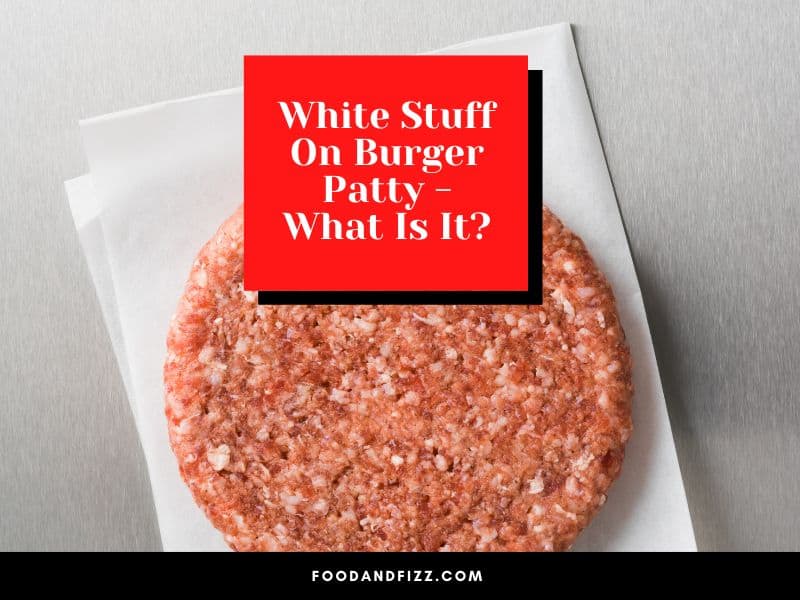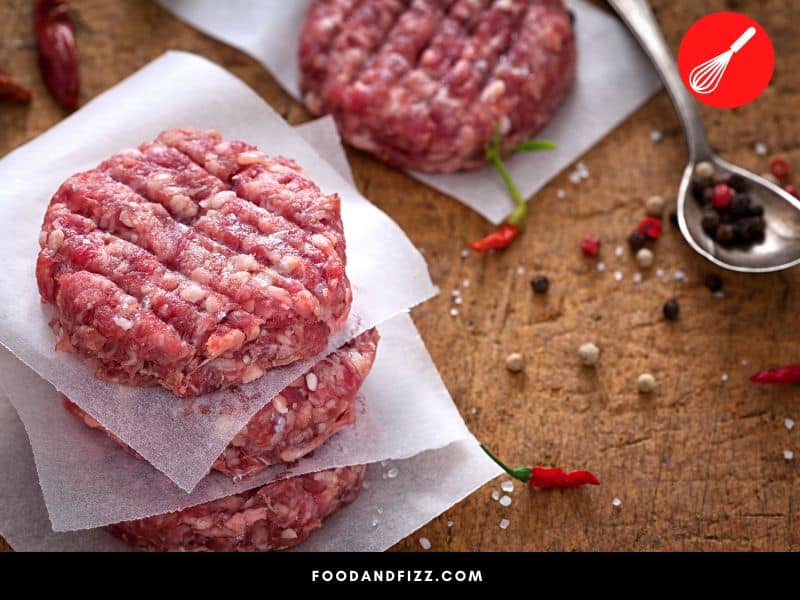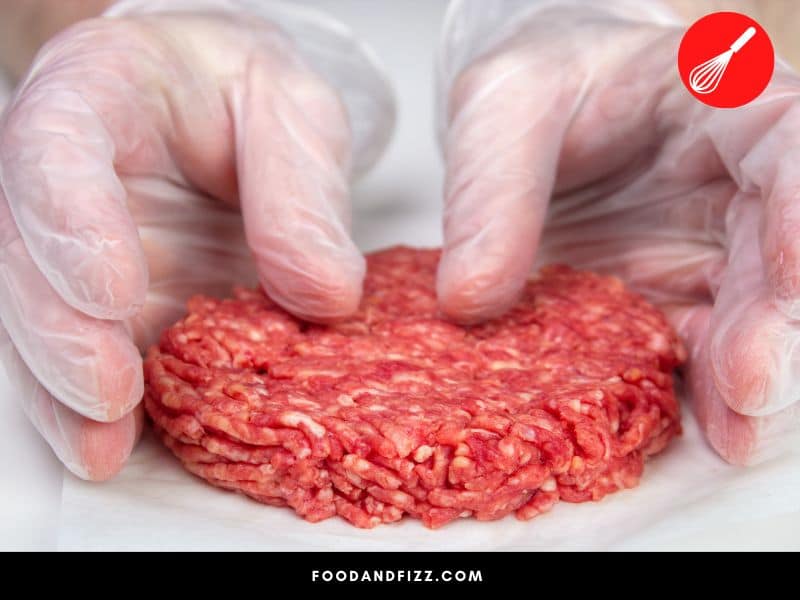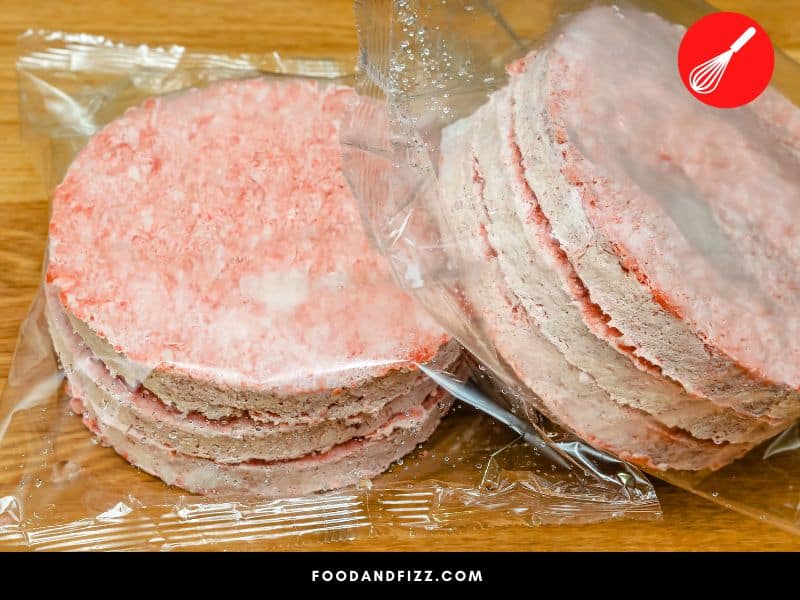When it comes to meat, we know that color signals freshness. And who wants to eat meat that’s not fresh? This is why, when look at our meat and see that it has a color other than red or pink or brown, we can understandably question its freshness and wonder whether it is safe to eat.
So you take out your burger patties and prepare to cook them when all of a sudden you notice some white stuff on them. What is it and is your meat safe to eat?
What Is the White Stuff on Burger Patties?
The white stuff on burger patties can either be due to the natural fat in the meat, freezer burn and other storage practices, or an indication that the meat has started to go bad. In the first two cases, it is safe to eat. But if your meat has gone bad, it is best to discard it as you can risk a food-borne illness if you consume it.

What Meat Are Burger Patties Made Of?
Burger patties are typically made with beef, although you can find them made with other meats as well, like pork, chicken, turkey, and even fish like salmon. Vegetarian burger patties are also available, which can be made with grains and legumes. When made with other meats, these will typically be labeled as such so if it is unlabeled, it can usually be assumed it is made with beef.

Is Burger Meat the Same as Ground Beef?
Burger patties resemble ground beef in that they are both ground-up beef, but they have an important difference. Both hamburger meat and ground beef cannot, by law, have more than 30% fat in their composition. This is what is known as the lean-to-fat ratio.
When ground beef has 30% fat, it means that its lean-to-fat ratio is 70/30. If it has 20% fat, it has an 80/20 lean meat to fat ratio. If it has only 10% fat, it has a 90/10 lean-to-fat ratio.
Most cooks agree that some amount of fat is needed to make the best, juicy burgers so an 80/20 ratio is generally accepted as a good balance of meat and fat for burgers. Some believe, though, that the 70/30 route is the best way to go to ensure moist, juicy, and flavorful burgers.
Okay so what’s the deal then between ground beef and hamburger meat?
To be labeled ground beef, it cannot have fat added from other sources to make up its fat ratio. For example, if your ground beef is ground sirloin, the fat can only come from sirloin. You cannot add fat from ground chuck to increase the fat ratio of your mix.
Hamburger meat, on the other hand, does not have this limitation. Fat from other less expensive beef parts and trimmings can be added to meet the fat content required for the burger patties, as long as it doesn’t go over the required maximum of 30%.
While both ground beef and burger meat can contain the same amount of fat, they are different in the source and way those fats are added.
Should I Be Alarmed If I See White Stuff on My Burger Patties?
If you see white stuff on your burger patties, it is easy to panic and assume that you should toss it out. While it is possible that your meat has spoiled if it has other signs of food spoilage, it is also possible that the white stuff is due to other things as well.
What else could the white stuff be?
Fat
The white stuff on your burger patties could just be part of the beef itself, otherwise known as fat. If your burger patty has a higher fat content, you might see more of these white spots on your patties.
White stuff can also be solidified protein or other stringy parts of the beef like ligaments and sinews.
Freezer Burn
If the white stuff is not from fat, it can be a form of discoloration due to freezer burn. Freezer burn happens when moisture is lost from meat due to the process of sublimation, or when a solid substance turns to gas without going through a liquid phase.
When meat is frozen, the moisture that is found in the meat freezes and turns into ice crystals. These ice crystals first make their way to the surface of the food (all of us have seen this in frozen food), and eventually want to leave the food and go to the coldest part of the freezer, which then dehydrates your meat and leaves it dry and shriveled up.
As the water molecules make their escape, oxygen can then creep in and do some damage by oxidizing the meat and dulling its color, as well as changing its texture and overall quality.
The longer the meat is frozen, the more susceptible to freezer burn. This is why, while things will not really go bad in the freezer, their quality will deteriorate over time.
If you see white stuff on your burger patty, freezer burn might be to blame.
Spoilage
If it isn’t fat or protein or ligaments or freezer burn, the white stuff may likely be a sign of food spoilage. Worms can appear as white strings in beef, so it is important to be extra careful.
Spoilage can also manifest as a white discoloration in the burger patty as bacteria proliferates in your spoiling ground beef.
It will usually be accompanied by other signs such as an off-putting smell and a slimy texture. If this is the reason for the white stuff in your burger patties, toss the meat! Besides the fact that it is gross, it isn’t safe to eat.

How Do I Know If My Burger Patties Are Still Good to Eat?
Meat that is ground up, as in burger patty meat, can go bad faster than whole cuts or slices of meat. This is because ground meat has more surface area that is exposed to bacteria, and thus will take less time to go bad.
In general, raw burger patties can only last about 1-2 days when stored in the fridge and up to 4 months when properly stored in the freezer.
Cooked burger patties, on the other hand, will last for about 3-4 days when properly wrapped and stored in the refrigerator. They can be stored in the freezer as well but the longer they are frozen, the more dried out they will become.
To know if your beef burger patties are still good to eat, we need to check their appearance, smell and texture, and take note of its expiry date and how it was stored.
1. It Looks A Little Strange
Fresh and good-to-eat burger patties will be reddish or pinkish in color or brownish in color. If it has blue or green spots or any fuzzy growths, and if it has obvious, uneven discolorations, it means it has gone bad and must be discarded.
White spots may indicate spoilage as well, although as we mentioned earlier, this isn’t necessarily the case as white spots can be caused by other things. In this case, we must continue to check for other signs of food spoilage.
2. It Smells Funky
The smell of the meat is probably one of the most tell-tale signs of spoilage. Fresh meat should not smell of anything else but meat. If it has a sulfur-like smell akin to rotting eggs, or an ammonia-like smell, or any other funky odor, that is a sure sign that your burger patties are no longer good to eat.
3. It Feels Different
Burger meat should be firm to the touch and should break apart when pressure is applied or when squeezed. If it feels slimy to the touch, feels sticky or is coated with a sticky film, it has likely gone bad.

4. It Wasn’t Stored or Handled Properly
Proper storage and handling is key to the safe consumption of meat. Ground meat like burger patties can be safely stored in the fridge for 1-2 days.
Cooked burger patties are good to enjoy for several days, up to 4 days, when properly wrapped and kept in the fridge.
Both raw and cooked burger patties can be stored in the freezer for an indefinite period of time, but it is generally advised to consume them within 4 months as they tend to lose their quality over time.
Any type of food, meat especially, should also not be left out at room temperature, or temperatures between 40 – 140 °F for more than 2 hours as this is the temperature range where bacteria proliferate rapidly on the food.
If you know your burger patties were not stored properly or were left out for more than two hours at room temperature, the possibility is higher that it has begun to spoil and is not safe to eat.
5. It’s Expired
Expiry dates are absolutely important when it comes to dealing with raw meat. Unlike other types of food where a few days past the expiration date is not that big of a deal, the risk is costly for meat and other fresh food.
If your package of burger patties is past its expiration date, it is best not to consume it as it means the meat is not as fresh as it should be and it is a big health risk to consume it.
What Happens If I Eat Burger Patties That Have Gone Bad?
Eating burger patties that have gone bad will likely lead to a foodborne illness. Food-borne illnesses, also popularly known as food poisoning, can range in severity from mild to serious and can resolve in as little as a few hours or may last for days to weeks.
Some cases resolve on its own while others may be more serious and may require hospitalization and may even be life-threatening. Some cases may even have lingering, long-term effects.
Symptoms include nausea, diarrhea, abdominal and muscle pain, vomiting, headaches, fever, dizziness, and neurological issues, among others.
If you ask me, it’s never worth it to risk getting food poisoning, even if the symptoms are mild. Following correct storage and handling procedures, cooking your meat to the safe internal temperatures, and sourcing from reputable butchers and sources all help ensure that we safeguard ourselves from this dangerous risk.
Besides, meat that has gone bad will not taste good, believe me. And as I always say, why eat it if it doesn’t taste good!
I Don’t Like White Stuff On My Burger Patties – What Do I Do?
To avoid white stuff on your burger patties, make sure to source from reputable butchers and suppliers to make sure that you are always getting safe and high quality burger patties that are stored and handled well.
You may also opt to get meat that is leaner and lower in fat, if the fatty tissue bothers you. Although as the experts say, fat is needed for burgers that are juicy and flavorful. You can’t go too low on this without compromising texture and flavor.
Lastly, make sure you properly store and handle your burger patties. It is best to get your burger patties fresh when you know you will cook them within a day or two.
If it is not possible, make sure to properly wrap and store them in airtight containers to avoid freezer burn, however, it is best not to keep them for too long in the freezer.
Remembering these tips will help minimize the possibility of white stuff appearing on your burger patty.

Frequently Asked Questions to White Stuff on Burger Patty
What Are The White Spots On My Ground Beef After Thawing?
White spots on your ground beef after thawing is likely due to freezer burn. Freezer burn causes color changes and moisture loss in meat, and an overall deterioration in quality.
What is the White Stuff in Beef?
White stuff in beef can either be congealed fat, hardened protein, discoloration caused by freezer burn, or a sign that your beef is beginning to spoil.
What is the White Stuff On Burger Buns?
White stuff on burger buns are likely due to flour residue.
What Happens if You Eat Bad Ground Beef?
If you eat bad ground beef, you will likely get either a mild or bad case of food poisoning.
Conclusion to White Stuff on Burger Patty
White stuff on burger patties can either be due to fat in the beef, freezer burn, or food spoilage. If it is because of fat or other natural parts of the beef, or because of freezer burn, it is safe to eat, though it won’t be as good.
If it is due to food spoilage because of the presence of other tell-tale signs, there is no other option but to toss it.
Remember, if you are unsure, it is safer to just toss it rather than risk a food-borne illness.

